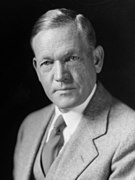| ||||||||||||||||||||||||||||||||||||||||||||||||||||||||||||||
36 of the 96 seats in the United States Senate 49 seats needed for a majority | ||||||||||||||||||||||||||||||||||||||||||||||||||||||||||||||
|---|---|---|---|---|---|---|---|---|---|---|---|---|---|---|---|---|---|---|---|---|---|---|---|---|---|---|---|---|---|---|---|---|---|---|---|---|---|---|---|---|---|---|---|---|---|---|---|---|---|---|---|---|---|---|---|---|---|---|---|---|---|---|
| ||||||||||||||||||||||||||||||||||||||||||||||||||||||||||||||
 Results of the elections: Democratic gain Democratic hold Republican hold Progressive gain Farmer–Labor hold No election | ||||||||||||||||||||||||||||||||||||||||||||||||||||||||||||||
| ||||||||||||||||||||||||||||||||||||||||||||||||||||||||||||||
The 1934 United States Senate elections were held in the middle of Democratic President Franklin D. Roosevelt's first term. The 32 seats of Class 1 were contested in regular elections, and special elections were held to fill vacancies. During the Great Depression, voters strongly backed Roosevelt's New Deal and his allies in the Senate, with Democrats picking up a net of nine seats, giving them a supermajority (which required 64 seats, two-thirds of the total 96 seats in 1934).[1] Republicans later lost three more seats due to mid-term vacancies (one to Farmer-Labor and two to Democrats); however, a Democrat in Iowa died and the seat remained vacant until the next election. The Democrats entered the next election with a 70-22-2-1 majority.
This marked the first time that an incumbent president's party gained seats in both houses of Congress in midterm election cycles, followed by 1998 and 2002.[2] This was also the second of three times since the ratification of the 17th Amendment that the opposition party failed to flip any Senate seats, alongside 1914 and 2022.
Cite error: There are <ref group=lower-alpha> tags or {{efn}} templates on this page, but the references will not show without a {{reflist|group=lower-alpha}} template or {{notelist}} template (see the help page).
- ^ Arthur Krock (November 7, 1934). "Tide Sweeps Nation". New York Times. Retrieved March 16, 2014.
- ^ "Statistics of the Congressional Election of November 6, 1934" (PDF). U.S. House of Reps, Office of the Clerk. Retrieved December 28, 2011.

